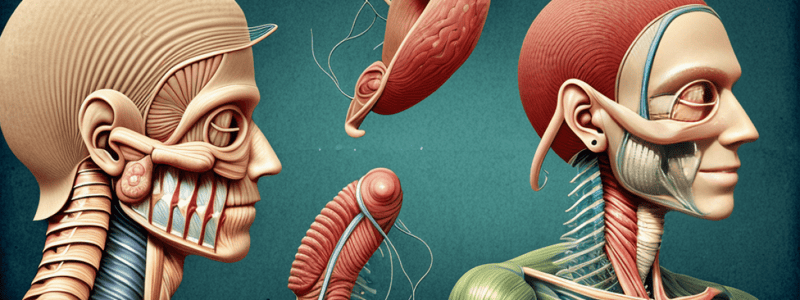Podcast
Questions and Answers
What is the function of the auricle?
What is the function of the auricle?
- To capture acoustic waves as a screen (correct)
- To stimulate the cerebral auditory centres
- To transform mechanical waves into acoustic waves
- To transmit acoustic waves to the eardrum
Where does the external auditory canal begin and extend to?
Where does the external auditory canal begin and extend to?
- Begins in the middle ear and extends to the inner ear
- Begins in the auricle and extends to the pinna
- Begins in the auditory cortex and extends to the cerebral auditory centres
- Begins in the ear and extends to the tympanic membrane (correct)
What is responsible for the transformation of acoustic waves into mechanical waves?
What is responsible for the transformation of acoustic waves into mechanical waves?
- Malleus, incus and stapes
- Auricle
- Tympanic membrane (correct)
- External auditory canal
Which part of the ear is made up of elastic cartilage tissue and numerous sebaceous and merocrine tubular glands?
Which part of the ear is made up of elastic cartilage tissue and numerous sebaceous and merocrine tubular glands?
What is the function of the middle ear?
What is the function of the middle ear?
Which structure connects the tympanic membrane to the middle ear?
Which structure connects the tympanic membrane to the middle ear?
What lines the cochlea?
What lines the cochlea?
Which part of the inner ear contains the cochlear duct?
Which part of the inner ear contains the cochlear duct?
What protects the cochlear duct?
What protects the cochlear duct?
What does the organ of Corti consist of?
What does the organ of Corti consist of?
Which type of cells define the outer tunnel and have basal nuclei?
Which type of cells define the outer tunnel and have basal nuclei?
What type of cells form a row on the tympanic lip of limbus?
What type of cells form a row on the tympanic lip of limbus?
Where are the neuroepithelial cells transformed into hair cells located?
Where are the neuroepithelial cells transformed into hair cells located?
What is the function of otoliths in the ear?
What is the function of otoliths in the ear?
Which structure houses the utricle and saccule, and contains specialized receptors and gelatinous cupulas?
Which structure houses the utricle and saccule, and contains specialized receptors and gelatinous cupulas?
What do the stereocilia in the ear form for outer hair cells and inner hair cells?
What do the stereocilia in the ear form for outer hair cells and inner hair cells?
What are the crystals located in the apical area of cupula made of?
What are the crystals located in the apical area of cupula made of?
Where do the semicircular canals originate from?
Where do the semicircular canals originate from?
What type of cells are characterized by highly developed type 92+2 cilia and stereocilia?
What type of cells are characterized by highly developed type 92+2 cilia and stereocilia?
Which cell type is responsible for transmitting vibrations to the chain of ossicles in the middle ear?
Which cell type is responsible for transmitting vibrations to the chain of ossicles in the middle ear?
Which structure is formed from interdental cells, associated with stereocilia, and connected to bone tissues of modiolus?
Which structure is formed from interdental cells, associated with stereocilia, and connected to bone tissues of modiolus?
Which type of cell contains macula saculi, is hook-shaped, and is oriented vertically?
Which type of cell contains macula saculi, is hook-shaped, and is oriented vertically?
Flashcards are hidden until you start studying
Study Notes
- Hensen's cells: tall columnar cells with few organelles, rest on basement membrane, define the outer tunnel, have basal nuclei and abundant cytoplasmic organoids.
- Outer phalangeal cells (Dieter cells): very elongated, basal nucleus, abundant cytoplasmic organoids, excavation in apical area for corresponding hair cells.
- Inner phalangeal cells: similar to outer phalangeal cells, house inner hair cells in apical area.
- Pillar cells: triangular cells, wide base on basement membrane, thin conical body, configure inner tunnel, outer pillar cells attached to hair cells.
- Marginal cells: columnar cells, form a row on tympanic lip of limbus.
- Organ of Corti: neuroepithelial cells are hair cells, transformed neurons, elongated columnar cells, euchromatic nucleus, acidophilic cytoplasm, stereocilia in apical portion, embedded in phalangeal cells.
- Structural features of hair cells: stereocilia in W pattern for outer hair cells, V pattern for inner hair cells, coupled to tectorial membrane, surrounded by mitochondria and smooth endoplasmic reticulum.
- Basement membrane associated with presynaptic bulbs, formed by ganglion cells in fibers of the acoustic nerve, located below hair cells.
- Tectorial membrane: formed from interdental cells, homogeneous, medium-density keratinized layers, associated with stereocilia, connected to bone tissues of modiolus.
- Vestibule: hollowed area in petrous temporal bone, houses utricle and saccule, contains maculae, specialized receptors, and gelatinous cupulas.
- Utricle: membranous diverticulum, contains macula saculi, hook-shaped, oriented vertically, covered with neuroepithelial cells.
- Saccule: membranous diverticulum, contains macula sacculi, kidney-shaped, oriented horizontally, covers neuroepithelial cells.
- Maculae: specialized receptors, contain neuroepithelial cells, supporting cells, gelatinous cupulas, and otoliths.
- Cilia and stereocilia: arranged in cupula, type I cells are globose with highly developed type 92+2 cilia and stereocilia, Type II cells are columnar with large proportions of 92 +2 cilia and stereocilia.
- Semicircular canals: originate from vestibule, host membranous semicircular canals, contain cristae ampullares, and are filled with cerebrospinal fluid.
- Crystals (otoliths): polyhedral concretions of calcium carbonate, located in apical area of cupula, beneath hair cells.
- Functions: sense balance and orientation, respond to acoustic waves, transmit vibrations to the chain of ossicles in the middle ear, and to the round window in the cochlea.
Studying That Suits You
Use AI to generate personalized quizzes and flashcards to suit your learning preferences.


